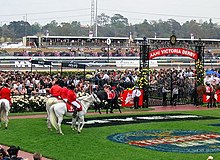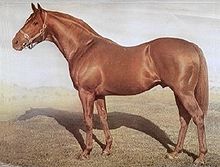Thoroughbred racing in Australia
[1] Horseracing commenced soon after European settlement, and is now well-appointed with automatic totalizators, starting gates and photo finish cameras on nearly all Australian racecourses.About 300,000 people have a direct interest as individual owners of, or members of syndicates which own, the 30,000 horses in training in Australia.[6] Manto, imported in 1825, was the first General Stud Book recorded Thoroughbred mare known by name to arrive in Australia.[8] Malua, foaled in 1879, was the most versatile Australian Thoroughbred racehorse, winning classic races on the flat and the VRC Grand National Hurdle before becoming a good sire.Bernborough, Kingston Town, Heroic, Makybe Diva (bred in England) and Winx were other champions that have been inducted into the Australian Racing Hall of Fame.Initially the British importations were identified on records with (imp) or an asterisk (*) added as a suffix to indicate that they were not locally bred.Some of these exported horses include, Bernborough, Shannon, Sailor's Guide, Noholme, Tobin Bronze and Royal Gem.The first official race meeting was organised by officers of Governor Macquarie's visiting 73rd Regiment and held at Hyde Park, Sydney in October 1810,[15] starting on Monday 15th and continuing on the Wednesday and the Friday.The Sydney Turf Club (STC) was formed in 1943 and held races on the Rosehill Gardens track and at Canterbury.In Victoria the first official races were held in March 1838 on a specially marked out course at Batman's Hill in Melbourne.[4][5] Charles Smith established Bungarribee stud at Doonside, New South Wales, shortly after 1830, which only had pure-bred English horses.[4] The three eastern mainland states supply 85% of Australian racehorses with the Hunter Valley being the favoured region for thoroughbred horses in New South Wales.[19] Stanley Wootton exerted a major influence on Australian racing when he imported the stallion Star Kingdom, now recognised as the most influential sire line in this country.[20] In the 1920s Hilda Thomas (b 1905) is reported to have raced in Western Australia, on special race-day granted permits, as she wasn't eligible for a jockey's licence [citation needed].Pam O'Neill and Linda Jones, in 1979, were the first women jockeys that were licensed to compete in registered races against men."In relation to the conducted energy devices, or the jiggers, clearly the allegation is that they may be used against a horse with the aim of improving their performance on a particular race day" Assistant Commissioner Neil Paterson said.[22] The Stud Book of New South Wales by Fowler Boyd Price was published in 1859, and was the first official attempt to document the pedigrees of the colony's bloodhorses.Equine influenza (EI) was initially discovered in a metropolitan Sydney horse complex in late August 2007, and spread to many areas of New South Wales and southern Queensland.The state boasts many top-class provincial and country racecourses including Pakenham, Cranbourne, Mornington, Geelong, Ballarat, Bendigo, Mildura, Stony Creek, Wangaratta, Warrnambool, Moe and Tatura.Other notable tracks include Hawkesbury, Gosford and Grafton which hosts the largest race carnival in Australia outside of a capital city.Other popular courses with feature races in Western Australia are Bunbury, Pinjarra, York, Geraldton, Albany, Kalgoorlie and Northam.There are Tasmanian meetings every Sunday usually alternating between Elwick Racecourse near Hobart, Tasman Park near Launceston and Spreyton, Devonport.Once a common sight in suburban pubs and bars, the introduction of telephone and internet betting at fixed prices by licensed on-course bookmakers has made it largely redundant.[8] In recent years, corporate bookmakers operating online and through mobile apps have become increasingly popular through various specials, promotion and ease of use.By tradition many state races have maintained higher gradings than they would otherwise be entitled to because of the poor quality of horses participating in them.






spectator sportAustraliagamblingTotalisator Agency BoardThoroughbredhorseracingflat racingSouth AustraliaAustralian rules footballrugby leagueautomatic totalizatorsstarting gatesphoto finishUnited StatesDoomben RacecourseAustralian Racing BoardAustralian Rules of RacingjockeysspringMelbourne CupVictoria DerbyVRC OaksChampions StakesGolden Slipper StakesCaulfield CupW. S. Cox PlatepedigreesLady PenrhynFirst FleetCape TownSouth AfricaArabian horseleading sires in AustraliaGeneral Stud BookNew ZealandCarbineAustralian Racing Hall of FameNew Zealand Racing Hall of FamePhar LapTullochBernboroughKingston TownHeroicMakybe DivaBlack CaviarTimeformnorthern hemisphereShannonSailor's GuideNoholmeTobin BronzeRoyal Gemcolourful languageSydney Turf ClubQueensland Turf ClubSouth Australian Jockey ClubNorthern TerritoryRobert CampbellWilliam LawsonJohn MacarthurJohn PiperD'Arcy WentworthDoonsideNew South WalesMelbourne CupsVictoria DerbiesAJC DerbiesHunter ValleyQueenslandDarling DownsGeelongTranquil StarBriseisStar KingdomBletchinglyMarscayTodmanKia Ora Stud2,000 Guineas StakesAmounisBiscayScobie BreasleyEdgar BrittMick DittmanRoy HigginsGeorge T. D. MooreNash RawillerHarry WhiteBill WilliamsonVictoria, AustraliaBart CummingsTommy SmithJack DenhamLee FreedmanColin HayesDavid HayesEtienne L. de MestreJames ScobieGai WaterhouseChris WallerJohn HawkesVictoria PoliceWarrnamboolBallaratcocaineWilliam Cross YuilleAustralian Stud Bookracing coloursEquine influenzaVictoriaCox PlateRacing Victoria LimitedVictoria Racing ClubFlemingtonMelbourne Racing ClubCaulfieldSandownMoonee Valley Racing ClubWeight for AgeTaturaAustralian Turf ClubRandwickWarwick FarmRosehill GardensCanterbury ParkMorphettville
